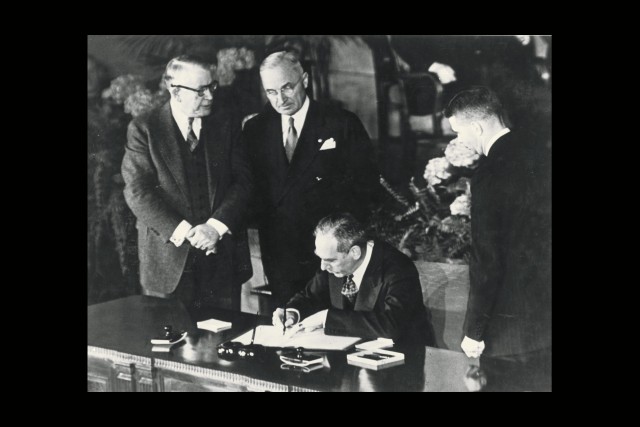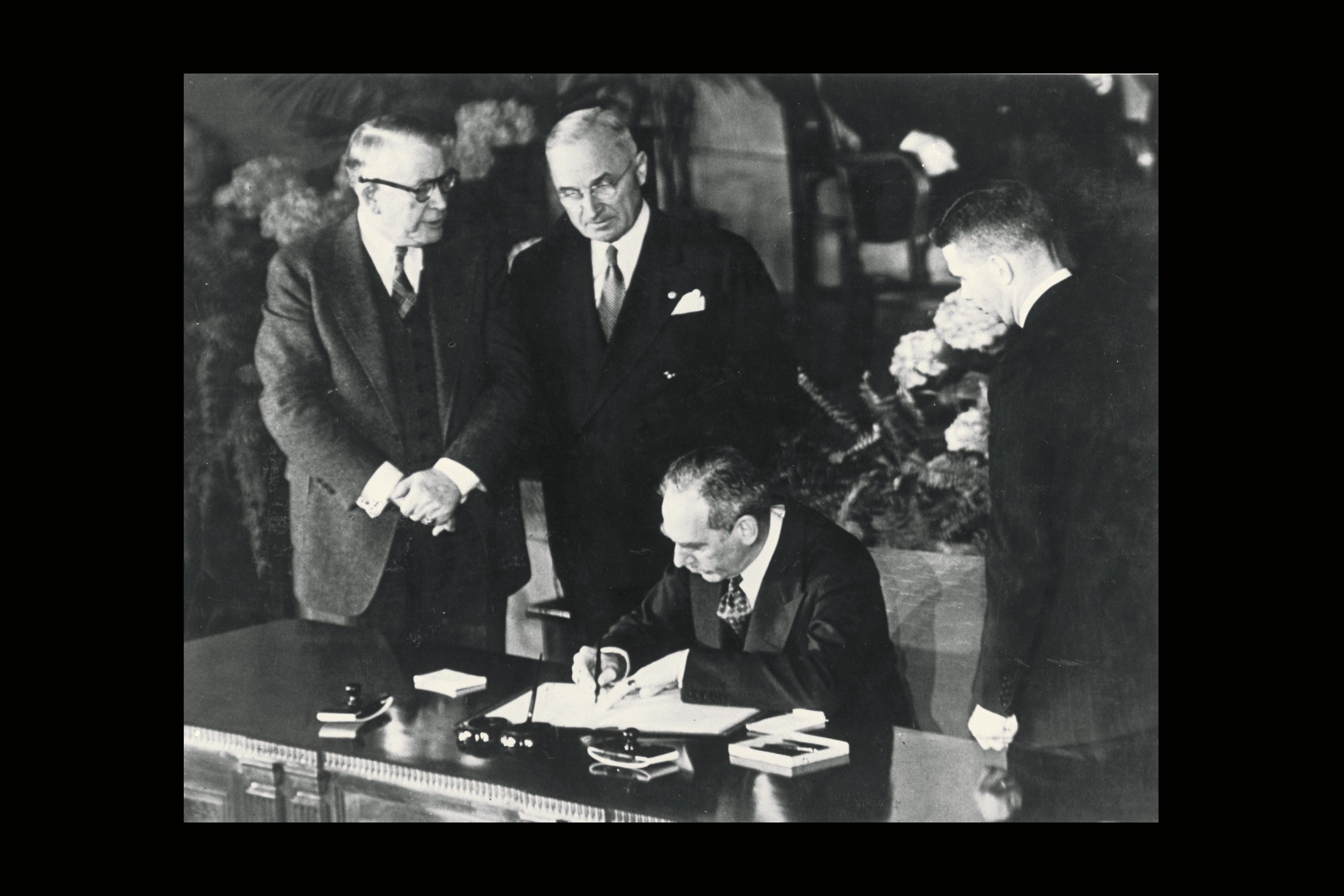CHIAfE+VRES, Belgium - Six decades ago this week, a dozen nations came together in Washington, D.C., to sign the North Atlantic Treaty. By doing so, the European and North American countries reaffirmed their commitment to each other, agreeing that if one was attacked, the alliance would take necessary actions to restore and maintain the security of the region.
That commitment still holds true today and now includes 26 - soon to be 28 - member nations.
The NATO Secretary General Jaap de Hoop Scheffer recently told the German Marshall Fund of the United States Brussels Forum that, "the Alliance's relevance is more widely accepted than ever before."
However, he added that the 60th Anniversary Summit, scheduled for April 3 and 4, is not just an event to commemorate the history of NATO. "On the contrary," he said, "that Summit is very much about the future of the Alliance."
"Just remember NATO's 50th anniversary in 1999," he said. "That summit took place against the backdrop of a controversial air operation in the Balkans. At its 40th anniversary, in 1989, it even looked as if NATO could break apart over differences of how to respond to the Gorbachev challenge.
"By contrast, today no one seriously argues that NATO's days are numbered. Two new members [Albania and Croatia] are on the verge of joining NATO, and France is about to take its full place again in our integrated military structure. We have never been in greater demand, yet we have never been confronted with bigger challenges," he said.
Army Gen. Bantz J. Craddock, the Supreme Allied Commander Europe and commander of U.S. European Command, addressed some of those challenges during a House Armed Services Committee hearing on March 24.
"What keeps me up at night is the concern of some NATO nations that there must be a solidarity in the alliance, and the call for an article 4 or an article 5 force to guarantee sovereignty or to repel attack has to be answered in a positive way quickly," he told the committee.
"That also transcends then into my European Command hat because, obviously as the leader of NATO, the United States will have to respond accordingly," he continued.
"We are the leaders of the alliance. We must be in the alliance. We must be present for duty, visible and that means with forces. That means in the diplomatic mode, the economic mode. We have to show that leadership - day in and day out. We have to build partners, member nation confidence and capabilities and also we have to build non-NATO partners who, in the coming years, want to be a part of the alliance."
In addition to ensuring NATO solidarity among all the member nations, one of the general's immediate concerns is America's force strength in Europe and how it directly relates to NATO. He recommended to the committee that the force remain at its current levels.
He said a draw down below 84,000 would mean "less engagement, less partner nation capability. Exercises will go unfunded and unmet, and we will essentially become absent in the theater where we have been so present before."
That European presence directly correlates to America's footprint on the battlefield. The general said that 87 percent of the allied contribution to Afghanistan and 70 percent of the contribution to Iraq have come from the EUCOM area of responsibility because of the engagement, cross-leveling and partnerships with NATO that have developed year after year.
He added that when the U.S. completes its plus-up in Afghanistan, that the U.S. will consist of more than 50 percent of the force. Those future forces will include the 17,000 that President Barack Obama has ordered to the region.
This spring, approximately 4,000 U.S. troops will deploy to train the Afghan security forces, according to remarks made March 27 by Obama when he introduced his future strategy for NATO's joint mission in Afghanistan.
Craddock said that while the U.S. was training the Afghan National Army, there was no increased commitment to police training. "The United States realized, if we're going to make this work with security forces, we've got to have public security police and national security Army, and that's when the U.S. took over the lead for police training."
Under Obama's new strategy the president said, "Every American unit in Afghanistan will be partnered with an Afghan unit, and we will seek additional trainers from our NATO allies to ensure that every Afghan unit has a coalition partner."
He added that military strength is not the only resource he seeks from NATO. He also is requesting support in creating clearly defined capabilities, support for Afghan elections and a greater civilian commitment to the Afghan people.
"We have a shared responsibility to act - not because we seek to project power for its own sake, but because our own peace and security depends upon it," he said. "And what's at stake now is not just our own security - it is the very idea that free nations can come together on behalf of our common security. That was the founding cause of NATO six decades ago. That must be our common purpose today."
As NATO evolves and grows, Col. James Drago, commander, U.S. Army Garrison Benelux, said his mission is synchronized to meet the demands and requirements requested by the administration.
USAG Benelux has three indirect reporting garrisons that support the NATO Headquarters in Brussels; NATO's Allied Command Operations at the Supreme Headquarters Allied Powers Europe near Mons, Belgium, and NATO's Allied Joint Force Command in Brunssum, The Netherlands.
"We are expanding training areas; we are improving quality of life facilities for families whose spouses are assigned to NATO, and we continue to open up our Army operations to our joint forces and international allies, when appropriate," said Drago.
As an example, the Benelux just conducted a joint mission rehearsal exercise with the 650th Military Intelligence Group/Allied Command Counterintelligence to prepare its personnel for an upcoming deployment to Afghanistan.
"Our garrison has supported NATO since its move to Belgium in 1967, and under the guidance of the Department of the Army and the Installation Management Command-Europe, we will continue that mission to ensure our alliance safeguards the freedom, common heritage and civilization of our people, as was intended by the original treaty signed 60 years ago."
The NATO Secretary General considers the past 60 years a "tremendous journey."
"From a mere piece of paper, the Alliance has turned into one of the world's premier international organizations," he said. "From just 12 member states, we went to 26 - and soon 28. And from a purely 'eurocentric' Alliance NATO has evolved into a security provider that is engaged on several continents, working with a wide range of other nations and institutions.
"A pretty impressive track record, if you ask me. A strong testimony of our collective ability to meet any kind of challenge," the Secretary General added. "And, above all, a very good reason to look to NATO's future with confidence."
Related Links:
VIDEO: NATO's 60th anniversary, part 1


Social Sharing